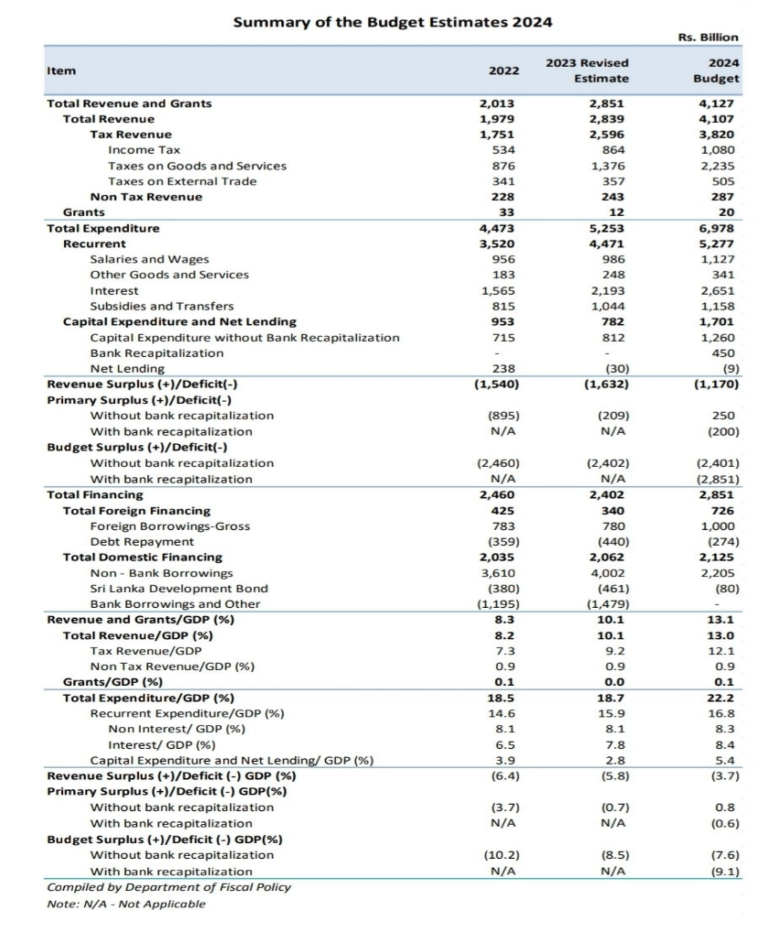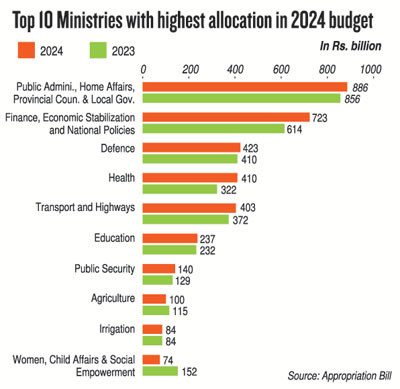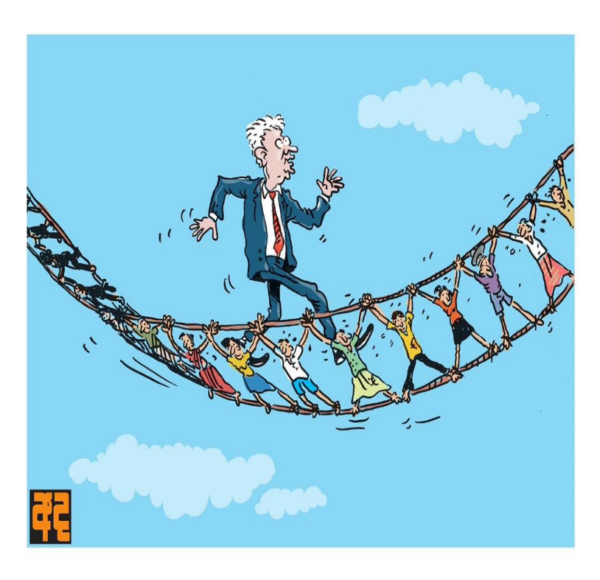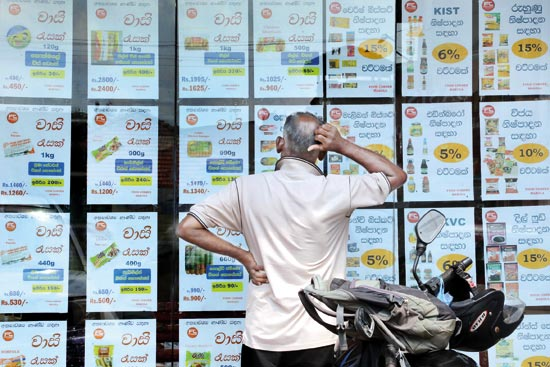Budget 2024: ‘Deep Marketisation’ in Sri Lanka
B. Skanthakumar
Ranil Wickremesinghe’s Budget for 2024 had safe passage on third reading on 13 December as expected, with a majority of 41 votes in the 225-member legislature. The Sri Lanka Podujana Peramuna (SLPP—People’s Front) with its rotten majority in parliament, having selected Wickremesinghe as president last year, made sure of that. There were 122 votes in favour and 81 votes against, with one abstention and the remainder not voting.
The ailing SLPP leader and former president Mahinda Rajapaksa voted in favour. On second reading, he described the budget proposals as “future-oriented”.[i] Rajapaksa fils, who has been posturing as Wickremesinghe’s critic and ‘friend of the suffering masses’ while seated on the government benches, absented himself. The regime that has provided immunity to his family from their political and economic crimes must not fall; but neither must he fall with Wickremesinghe at the ballot box.
The Budget Speech estimates government expenditure in 2024 to be 6.5 trillion LKR.[ii] This is an increase of 24% in comparison to 2023, which appears surprising when Sri Lanka is in an International Monetary Fund (IMF) programme oriented to reducing public spending. However, this is more than offset by the depreciation of the LKR by 44.8% of its value against the USD, over the course of 2022.[iii] With next-to-no domestic production for home market consumption, and a highly import-dependent economy fostered by the ‘open economy’ reforms since 1977, many more rupees are required to finance a whole lot less.
The government’s revenue target in 2024 is 4.1 trillion LKR, as against an anticipated 2.76 trillion LKR by year’s end.[iv] In view of its expenditure estimate, this means that for every 100 LKR in government revenue in 2024, it will spend over 150 LKR. This chronic deficit between revenue and expenditure – marked by persistent over-estimation of income and under-estimation of spending in government budgets – has for decades been plugged by borrowing: through domestic and foreign debt. The unsustainability of this practice, with its vulnerability to internal and external shocks, was what triggered post-colonial Sri Lanka’s worst and ongoing economic crisis.[v]
Shrinking economy
However, how to increase revenue when Sri Lanka’s economy has continued to shrink over the course of 2023? Last year, the economy contracted by an unprecedented 7.8%.[vi] The blithe pronouncements by regime-devotees on how “normalcy” has been restored in Wickremesinghe’s regnancy, are belied by the further slump in the economy by 7.9% in the first half of 2023. More than 500,000 jobs were lost in 2022 alone. One in five small and medium enterprises, where most employment is generated, did not survive the double-whammy of the COVID-19 pandemic accompanied by the economic crisis.
There is an exponential increase in the number of the poor: around 25% of the population are now below the official poverty line; the minimum monthly expenditure per person to meet basic needs is calculated as an absurd 16,112 LKR as of October 2023.[vii] More than half-a-million households have been thrown off-the-grid in the first ten months of this year, as the Ceylon Electricity Board disconnected 544, 488 connections (approximately 50,000 each month), for non-payment of bills.[viii]
The Central Bank has commended itself on the dramatic decline in headline inflation, now down to single digits – the Colombo Consumer Price Index was 3.4% in November – following the statistical sleight-of-hand effected through changing the base year for its calculation to 2021 when prices began their staggering climb.[ix] While happily the rate of increase in prices has significantly slowed this year – remember that headline and food inflation peaked at 69.8% and 94.9% respectively in September 2022[x] – the general price level has increased according to the Department of Census and Statistics, by an average of 93.4% in comparison to two years ago.[xi] When it comes to many staple foods ranging from dhal, eggs, fish, meat, rice, wheat flour, and so on, prices are now several-fold higher than pre-crisis.
There is bad news on the balance of trade front too, as the deficit between import expenditure and export revenue steadily grew, totalling 4 billion USD in the first 10 months of 2023.[xii] This is unsurprising given the government relaxed controls on almost all imports since June; while the export value for industrial and agricultural products has fallen sharply. The crisis of production (and therefore also employment) in the apparel or ready-made-garments sector shows no sign of abating, recording a 20% year-on-year decline.[xiii] Between January and October 2023, earnings from tea increased by almost 4%; but decreased in rubber and rubber-finished products by almost 12%, and in coconut and coconut-based products by almost 17%. Meanwhile imports have surged in fuel, sugar, and milk powder.
Fortunately, and with no credit to the government nor the IMF, migrant worker remittances mostly contributed by women in domestic work and men in construction work in West Asia (particularly Kuwait, the United Arab Emirates, and Qatar), have bounced back in 2023 to a little under 500 million USD monthly or 4.35 billion USD in the first nine months of 2023.[xiv] There has also been an uptick in tourist arrivals to 1,276,951 – mostly from India, Russia, Britain, Germany, and China – in the first 11 months of this year; with receipts of 1.79 billion USD so far.[xv]
These inflows should be compared with that of foreign capital. This regime claims that its economic and political policies are those that are most conducive to investors from overseas; and that their investments are the antidote to Sri Lanka’s economic malady. However, between January and October of 2023, net foreign direct investment has been a pathetic 305 million USD.[xvi] It is the labour income of migrant workers’, and earnings from foreign tourism, that keeps this maldeveloped economy from stalling as it did last year.
Thanks to these inflows, usable foreign reserves (that is, excluding the Chinese currency swap equivalent to 1.4 billion USD) have climbed to 2.184 billion USD as of the end of November 2023, which would cover a little over five weeks of imports.[xvii] This is only of relief in comparison to May of 2022 when Sri Lanka had only 50 million USD in its coffers.[xviii] The rupee has also stabilised at around 326 LKR = 1 USD. It seems a lifetime ago, but at the end of 2021 it was trading at 200 LKR to the US dollar.[xix]
In a condition of such abject socio-economic deterioration, what explains the government’s projected increase in revenue in 2024 by a whopping near 45%? In keeping with the strictures of the IMF programme, the government must progressively decrease the budget deficit as a percentage of GDP (gross domestic product or the size of the economy) following pre-determined targets. To reduce the budget deficit to 7.6% of GDP in 2024, without wielding the axe too wildly on recurrent government expenditure (mostly public sector salaries and pensions), there must be a dramatic jump in government revenue. A new Revenue Management Authority was announced in the Budget Speech, to intensify collection from the departments of Inland Revenue (direct and indirect taxes on personal and corporate income and consumption and internal trade); Customs (duties and levies on external trade); and Excise (taxes on alcohol and tobacco).
However, the government is mostly banking on increased taxes mostly from the administration of Value-Added-Taxation (VAT), by raising the rate to 18% (from the current 15%) and by lowering the threshold for registration of companies to turnover of 60 million LKR per annum and above, to realise its revenue target. As the rise in VAT takes effect from January 2024 – and more suppliers, of 97 more goods and services, are subject to it – costs will rise across the board, disproportionately hurting the quality of life and standard-of-living of the poor
What a progressive government would do instead is to relieve the burden of indirect taxation off the backs of the poor so that their incomes can be channelled into basic needs; while shifting it onto the corporates that continue to benefit from tax holidays; the banks and financial services industry reaping super-profits through the pandemic and beyond; and the conspicuous consumption and obscene wealth of the ultra-rich.

As Sharmini Coorey, former IMF official and current advisor to the President had cause to observe in relation to existing tax exemptions for the Colombo Port City, export processing zones, and so-called strategic development projects: “… in Sri Lanka we have welfare for the rich and super-rich that far outweighs the small amounts the Government transfers to the poor…”.[xx]
Tightrope walking?
“A tightrope walk” is how one post-budget discussion described Budget Speech 2024: referring to Wickremesinghe, who is also Minister of Finance, negotiating socio-economic respite for politicians and voters (with parliamentary and presidential elections due next year) with political-economic reassurance of ‘fiscal consolidation’ (that is, reduction of the budget deficit and government debt through austerity measures) to the International Monetary Fund.[xxi]
In the lead-up to the Budget debate, there were ritual, mostly lunch-break protests by public sector unions agitating for an 20,000 LKR monthly increase in their salaries. There has been no wage increase in the public sector since 2015, apart from modest revisions for teachers and principals in 2021 following months of all-island industrial action.
In 2019, mean monthly household expenditure was calculated by the Department of Census and Statistics (DCS) as LKR 63,130 and average household monthly income at 76,414 LKR.[xxii] Of course, these all-island statistics that assume the size of the household to be only four persons, mask the substantial differences between the urban, rural, and estate sectors; and between and across provinces and districts. This most recent DCS survey was also pre-pandemic and pre-crisis, before the rupee sank and the cost-of-living soared. Income inequalities have also sharpened since 2021: when already the richest 1% commanded 20.6% of income share in stark contrast to the 17.9% held by the poorest 40% of the population.[xxiii] It is not fanciful to reckon from lived experience, that household expenditure has since doubled, while income has stagnated at best and waned at worst for the bottom deciles.

There are 1.3 million public sector workers in the 8.2 million labour force; and 730,000 state pensioners. These are sizeable vote banks, along with their family members, to be courted in an election. What this Budget does though is to freeze salaries and pensions, while enhancing the cost-of-living-allowance (COLA) by 10,000 LKR and 2,500 LKR respectively. Additionally, the statutory deduction for the widows’ and widowers’ and orphans’ pension scheme is raised to 8% (from 6%), reducing the take-home salary of public sector workers. To address their “economic hardships”, the Budget proposes resuming the distress loan scheme for public servants, heightening their vulnerability to indebtedness.
Social welfare spending will be boosted in comparison to this year, according to the Budget Speech. The government’s new cash transfer scheme Aswesuma has been expanded to cover two million households, and its allocation is promised to treble to 183 billion LKR. There is a 50% rise in the monthly allowances for persons with disabilities and those afflicted by chronic kidney disease to 7,500 LKR, and for elders to 5,000 LKR, for which 138 billion LKR is set aside. Unfortunately for these groups as with other citizens, the real value of the increment is more than wiped out by the massive price increase in healthcare, transport, electricity, fuel, and essential foods, since 2022.
In contrast, military spending continues its year-on-year increase to almost 424 billion LKR, in what will be 15 years since the end of the war. Almost half of this allocation are salaries for the 200, 873 personnel: most of whom are an occupying power in the Tamil-speaking majority northern and eastern regions.
In adherence to the IMF programme, the Budget has earmarked 3 trillion LKR, that is 65% of forecast government revenue, for sovereign debt restructuring with domestic and external creditors including holders of government bonds. This allocation for debt-servicing is many times more than the combined expenditure on education, health, and social protection. The regime’s aim is to begin repaying the creditors of its suspended debts, thereby rehabilitating the risk rating on its sovereign bonds, to resume more borrowing in the future.[xxiv]
To protect the state banks from collapse, following politically-influenced bad lending to crony capitalists and loss-making state-owned-enterprises like Sri Lankan Airlines, the Ceylon Electricity Board, and the Ceylon Petroleum Corporation, the public will have to fork out 450 billion LKR next year for re-capitalisation of the Bank of Ceylon and the People’s Bank. For additional capital, 20% of the share value of the two banks will be floated – in other words, this is the first step towards their privatisation. To finance both debt-restructuring and recapitalisation, the Budget Speech proposes almost doubling the limit for government debt from 3.9 trillion LKR to 7.35 trillion LKR.

While the IMF, World Bank, and the government brag about the “social safety net” that they are weaving through the Aswesuma programme, its holes are so large that people in need are falling straight through.[xxv] This unholy trinity are stealthily dismantling Sri Lanka’s social security system. The universal provision of free education and health is de facto denied through under-funding. The disintegration of state provision of public goods is precipitated by stretching infrastructure, staff, and users, to breaking point. The aim is to prepare the objective and subjective conditions for direct or indirect or partial privatisation: the corporate capture of the considerable assets of state institutions, and the monetisation of public services.[xxvi]
Since legislative adoption of the regime’s revenue proposals, the IMF has approved the second tranche of about 337 million USD from its Extended Fund Facility loan to Sri Lanka.[xxvii] It is reassured that the President maintains parliamentary support; has steamrollered opposition to domestic debt restructuring that penalises workers’ retirement funds[xxviii] – demonstrating political will to meet the agreed conditionalities (“revenue-based fiscal adjustment”); and that most bilateral creditors are agreeable to restructuring 5.9 billion USD[xxix] from Sri Lanka’s external (commercial, bilateral, and multilateral) debt as of end-September 2023 totalling 36,384.50 billion USD.[xxx] As the IMF staff report upon first review of the government’s performance confirmed: “The draft 2024 budget is consistent with program parameters”.
In Wickremesinghe’s circus, it is never the ringmaster who walks the tightrope.
Public-Private Partnerships
What else stands out in this Budget Speech? Certainly, the focus on higher education reform and expansion is striking.[xxxi]
At least eight new public universities, even as the present number grapple with academic staff shortages through out-migration and declining ratios of investment to each student owing to the government freeze on capital expenditure. There is also state support for expansion in the number and intake of private universities, including through loans for school-leavers, that intensifies financialisation within the economy. There is encouragement for provincial councils to register universities. It is inconceivable that this government will make public funds available for this purpose, when it is already devolving income-generation for capital expenditure onto universities. Hence, ‘public-private partnerships’ with domestic and foreign business for infrastructure and operational costs; and their return-on-investment through fee-levying, will be normalised.
The other take-away is the aggressive drive to commodify and privatise housing, land, and property: a new frontier for private capital in Sri Lanka.
Two million farmers who have been living and working on state lands (on inter-generational permits) are to receive legal title to their plots. Estate residents are promised land ownership and new housing. Nearly 50,000 urban poor households currently renting state-owned housing will be granted ownership. Through titling of land and housing, a new market will be created, where through the relentless logic of the market, those in possession will for reason of speculation or survival, surrender their only asset through sale or lease or rent.[xxxii]
Through lease or concession 300,000 acres of state land currently managed by the state plantation corporations, the Mahaweli Authority, and the Land Reform Commission, are to be assigned for “large scale agricultural activities”. This will be export-oriented production with pauperised farmers or the rural landless, working the land. Likewise, the National Livestock Development Board farms will be leased to commercial interests for dairy production. Small tank rehabilitation in villages will be in partnership with agribusiness concerns, indicating that these corporates will gain direct control over water resources, while gaining the power through command of water rights to determine which crops/s are cultivated, and to monopolise their purchase. Likewise, fisheries harbours are to be operated in partnership with private capital, which suggests that industrial fishing and capitalists within the sector will have precedence in access and control.
Local government authorities are expected to gradually become self-financing (central government transfers will begin tapering off from 2024). Those bodies unable to match their revenue from rates, revenue licenses, stamp duty and court fines with their expenditure, will be compelled to lease their properties to businesses for income, or out-source their functions to commercial providers to reduce on salaries and capital costs.
State-owned prime real estate in city centres will be traded to companies for high-end commercial and residential development. The urban poor who live on state lands will be evicted. Railway stations and land in Anuradhapura, Colombo Fort, Galle, Jaffna and Matara, will be leased for mixed purpose projects including logistics, storage, and retail trade. State ministries and agencies that require additional infrastructure on land allocated to them, will enter build-own-operate-transfer arrangements with equity investors, paying “rent” until the cost of construction is settled.
Deep Marketisation
The paradigm in evidence in the Budget 2024 proposals above, could be described as “deep marketisation attempts to fuse the public and the private into a liberal market reality like never before, working on, through and around the state […] a project that privileges – contradictorily – private interest as being in the interest of the broader public”.[xxxiii]
Indeed, the thrust of the Wickremesinghe regime’s socio-economic framework is to expand the scope of market relations, particularly into areas that were partially insulated from commodification in the past such as education, land, and government services.
His ambition is to expand and deepen the transformation that was initiated by his uncle J. R. Jayewardene after 1977, with a 21st century twist of digitalisation, artificial intelligence, and green growth, enmeshing larger numbers and greater human activities in the net of capital accumulation. The ideology that accompanies this reordering of state-society-market relations seeks the de-legitimation of public provisioning and delivery and the commons; and to embed the private sector, financialisation and market values, in its place.
B.Skanthakumar is with the Social Scientists’ Association of Sri Lanka, and author of ‘Growth with Inequality: Neo-Liberal Reforms in Sri Lanka’ (South Asia Alliance for Poverty Eradication, Kathmandu 2013).
Notes
[i] “Sri Lanka’s ‘forward-looking’ 2024 budget will instil fiscal discipline: MR”, EconomyNext, 21 November 2023, available at https://economynext.com/sri-lankas-forward-looking-2024-budget-will-instill-fiscal-discipline-mr-141034/.
[ii] Wickremesinghe, Ranil (2023). Budget Speech 2024 – Prelude to a Stable Future, available at https://www.treasury.gov.lk /web/budget-speeches/section/2024.
[iii] Central Bank of Sri Lanka (2023). Annual Report 2022. Colombo: Central Bank of Sri Lanka, available at https://www.cbsl.gov.lk /sites/default/files/cbslweb_documents/publications/annual_report/2022/en/9_Chapter_05.pdf, p. 155.
[iv] “Sri Lanka anticipates record Rs 3 tn in revenue by end 2023: official”, EconomyNext, 21 November 2023, available at https://economynext.com/sri-lanka-anticipates-record-rs-3-tn-in-revenue-by-end-2023-official-141003/.
[v] Skanthakumar, Balasingham and Eric Toussaint (2022). “‘The Canary in the Coal Mine’: Sri Lanka’s Crisis is a Chronicle Foretold”, Committee for the Abolition of Illegitimate Debt (CADTM), 07 August 2022, available at http://www.cadtm.org/The-Canary-in-the-Coal-Mine-Sri-Lanka-s-Crisis-is-a-Chronicle-Foretold.
[vi] World Bank (2023). Sri Lanka Development Update: Mobilizing Tax Revenue for a Brighter Future. Washington DC: World Bank, available at https://openknowledge.worldbank.org/server/api/core/bitstreams/e8702694-0c68-4a7b-8cd2-006a821463d0/content, pp. 1-5.
[vii] Department of Census and Statistics (2023). Official poverty line by District – October 2023, available at http://www.statistics. gov.lk/povertyLine/2021_Rebase.
[viii] Weerasinghe, Tharushi (2023). “CEB disconnects electricity to over 500,000 defaulters”, The Sunday Times, 12 November 2023, available at https://www.sundaytimes.lk/231112/news/ceb-disconnects-electricity-to-over-500000-defaulters-538338.html.
[ix] Department of Census and Statistics (2023). Colombo Consumer Price Index November overview, 30 November 2023, available at http://www.statistics.gov.lk/InflationAndPrices/StaticalInformation/MonthlyCCPI/CCPIInfo2023E.
[x] Central Bank of Sri Lanka (2022). CCPI based headline inflation recorded at 69.8% on year-on-year basis in September 2022, 30 September 2022, available at https://www.cbsl.gov.lk/sites/default/files/cbslweb_documents/press/pr/press_20220930_inflation_ in_september_2022_ccpi_e.pdf.
[xi] Department of Census and Statistics (2023). Colombo Consumer Price Index November overview, 30 November 2023, available at http://www.statistics.gov.lk/InflationAndPrices/StaticalInformation/MonthlyCCPI/CCPIInfo2023E.
[xii] Central Bank of Sri Lanka (2023). External Sector Performance – October 2023, 30 November 2023, available at https://www.cbsl.gov.lk/sites/default/files/cbslweb_documents/press/pr/press_20231130_external_sector_performance_october_2023_e.pdf, p. 2.
[xiii] “Exports slump to five-month low in October”, Daily FT, 06 December 2023, https://www.ft.lk/top-story/Exports-slump-to-five–month-low-in-October/26-755966.
[xiv] “Sri Lanka received highest remittances from Kuwait, UAE and Qatar in 3Q2023”, The Island, 11 December 2023, available at https://island.lk/sri-lanka-received-highest-remittances-from-kuwait-uae-and-qatar-in-3q2023/.
[xv] “SL tourism fulfils 66% revenue target set for 2023”, Daily Mirror, 13 December 2023, available at https://www.dailymirror.lk/ business/SL-tourism-fulfils-66-revenue-target-set-for-2023/215-273121.
[xvi] Central Bank of Sri Lanka (2023). External Sector Performance – October 2023, 30 November 2023, available at https://www.cbsl.gov.lk/sites/default/files/cbslweb_documents/press/pr/press_20231130_external_sector_performance_october_2023_e.pdf, p. 7.
[xvii] Central Bank of Sri Lanka (2023). Weekly Economic Indicators, 08 December 2023, available at https://www.cbsl.gov.lk /sites/default/files/cbslweb_documents/statistics/wei/WEI_20231208_e.pdf, p. 15.
[xviii] Srinivasan, Meera (2022). “Sri Lanka’s usable reserves now negligible, says Finance Minister”, The Hindu, 05 May 2022, available at https://www.thehindu.com/news/international/sri-lankas-usable-reserves-now-negligible-says-finance-minister/ article65381941.ece.
[xix] Central Bank of Sri Lanka (2023). Indicative Exchange Rates, available at https://www.cbsl.gov.lk/en/rates-and-indicators/ exchange-rates/daily-indicative-exchange-rates.
[xx] Coorey, Sharmini (2023). “CBSL 73rd Anniversary Oration The Way Forward: Price stability and prosperity need good governance: Part 2”, Daily FT, 07 November 2023, available at https://www.ft.lk/opinion/CBSL-73rd-Anniversary-Oration-The-Way-Forward-Price-stability-and-prosperity-need-good-governance-Part-2/14-754919.
[xxi] Wickremesinghe in his budget opening speech of 13 November and closing speech on 13 December, once more invoked Bertolt Brecht’s Caucasian Chalk Circle. It was last year that he first likened himself to the servant-girl Grusha who crosses a perilous rope bridge, to selflessly save a baby from soldiers in hot pursuit.
[xxii] Department of Census and Statistics (2022). Household Income and Expenditure Survey – 2019 Final Result (January to December 2019), available at http://www.statistics.gov.lk/IncomeAndExpenditure/StaticalInformation/HouseholdIncomeand ExpenditureSurvey2019FinalResults, p. 7 and p. 2.
[xxiii] United Nations Development Programme (2023). Statistical Annex, 2024 Regional Human Development Report – Making Our Future: New Directions for Human Development in Asia and the Pacific. New York: UNDP, available at https://www.undp.org /asia-pacific/publications/making-our-future-new-directions-human-development-asia-and-pacific, Table 3.
[xxiv] Skanthakumar, Balasingham (2023). “Bailing Out the Creditors”, Rosa-Luxemburg-Stiftung, 19 October 2023, available at https://www.rosalux.de/en/news/id/51149/bailing-out-the-creditors.
[xxv] Perera, Iromi (2023). “Aswesuma: High Exclusion, Low Transparency?”, Groundviews, 04 December 2023, available at https://groundviews.org/2023/12/04/aswesuma-high-exclusion-low-transparency/; Kotagama, Hemasiri (2023). A Rapid Appraisal of the ‘Aswesuma’ Social Benefit Scheme, Centre for Poverty Analysis Blog, 27 June 2023, available at https://www.cepa.lk/blog/a-rapid-appraisal-of-the-aswesuma-social-benefit-scheme/; Feminist Collective for Economic Justice (2023). “World Bank and IMF’s targeted discourse against working poor of Sri Lanka”, Daily FT, 08 May 2023, available at https://www.ft.lk/opinion/World-Bank-and-IMF-s-targeted-discourse-against-working-poor-of-Sri-Lanka/14-748032.
[xxvi] Gunawardena, Madhulika and Sinthuja Sritharan (2023). “Budget 2024 and the working people”, Daily FT, 28 November 2023, available at https://www.ft.lk/opinion/Budget-2024-and-the-working-people/14-755657; Feminist Collective for Economic Justice (2023). “Into the abyss”, Daily FT, 01 December 2023, available at https://www.ft.lk/opinion/Into-the-abyss/14-755795. Pathirana, Dhanusha Gihan (2023). “Taxing the Poor to Reward the Rentiers”, Daily Mirror 09 December 2023, available at https://www.dailymirror.lk/opinion/Taxing-the-Poor-to-Reward-the-Rentiers/172-272910.
[xxvii] International Monetary Fund (2023). Sri Lanka: First Review Under the Extended Arrangement Under the Extended Fund Facility, 12 December 2023, available at https://www.imf.org/en/Publications/CR/Issues/2023/12/12/Sri-Lanka-First-Review-Under-the-Extended-Arrangement-Under-the-Extended-Fund-Facility-542441.
[xxviii] Kadirgamar, Ahilan; Gunawardena, Madhulika; Rafaithu, Shafiya; and Sinthuja Sritharan (2023). “Frequently asked questions on domestic debt restructuring”, Daily FT, 12 September 2023, available at https://www.ft.lk/opinion/Frequently-asked-questions-on-domestic-debt-restructuring/14-752873.
[xxix] Jayasinghe, Uditha and Tetsushi Kajimoto (2023). “Sri Lanka and creditor nations agree in principle on debt restructuring”, Reuters, 29 November 2023, available at https://www.reuters.com/world/asia-pacific/creditor-nations-likely-agree-sri-lanka-debt-restructuring-report-2023-11-29/.
[xxx] Ministry of Finance, Economic Stabilization and National Policies (2023). Quarterly Debt Bulletin, 30 September 2023, available at https://www.treasury.gov.lk/api/file/c90fb6c6-17fb-4940-ad28-eb710dc33cff, p. 4.
[xxxi] Ranil Wickremesinghe was of course the Minister of Education in the United National Party (UNP) government that issued the 1981 White Paper, Education – Proposals for Reform. See Manuratne, Prabha (2017). “‘Kolombata Kiri, Apita Kekiri’: Neoliberalism and the 1981 Educational Reforms”, Polity, Vol. 7, Issue 2: 14-22, available at http://ssalanka.org/kolambata-kiri-apata-kekiri-neoliberalism-and-the-1981-education-reforms-prabha-manuratne/.
[xxxii] Thudugala, Sandun and Sumudu Chamara (2023). “‘Liberalising land mkt. sans a public interest policy, is ludicrous’”, The Morning, 28 November 2023, available at https://www.themorning.lk/articles/WK1GPkjXOFXU0CQu2tfH.
[xxxiii] Carroll, Toby (2012). “Working On, Through and Around the State: The Deep Marketisation of Development in the Asia-Pacific”, Journal of Contemporary Asia, Vol. 42, No. 3: 378-404, p. 384 and p. 400 respectively.

